
|
Astronomy Picture Of the Day (APOD)
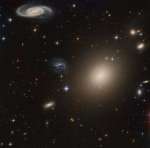 Galaxies Away
Galaxies Away
25.05.2018
This stunning group of galaxies is far, far away, about 450 million light-years from planet Earth and cataloged as galaxy cluster Abell S0740. Dominated by the cluster's large central elliptical galaxy (ESO 325-G004)...
 The Gum Nebula Expanse
The Gum Nebula Expanse
24.05.2018
Named for a cosmic cloud hunter, Australian astronomer Colin Stanley Gum (1924-1960), The Gum Nebula is so large and close it is actually hard to see. In fact, we are only about 450 light-years from the front edge and 1,500 light-years from the back edge of this interstellar expanse of glowing hydrogen gas.
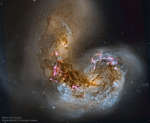 Spiral Galaxy NGC 4038 in Collision
Spiral Galaxy NGC 4038 in Collision
23.05.2018
This galaxy is having a bad millennium. In fact, the past 100 million years haven't been so good, and probably the next billion or so will be quite tumultuous. Visible toward the lower...
 Craters and Shadows at the Lunar Terminator
Craters and Shadows at the Lunar Terminator
22.05.2018
Why does the right part of this image of the Moon stand out? Shadows. The terminator line -- the line between light and dark -- occurs in the featured image so that just over half the Moon's face is illuminated by sunlight.
 Jupiter Cloud Animation from Juno
Jupiter Cloud Animation from Juno
21.05.2018
How do Jupiter's clouds move? To help find out, images taken with NASA's Juno spacecraft during its last pass near Jupiter have been analyzed and digitally extrapolated into a time-lapse video.
 In the Heart of the Tarantula Nebula
In the Heart of the Tarantula Nebula
20.05.2018
In the heart of monstrous Tarantula Nebula lies huge bubbles of energetic gas, long filaments of dark dust, and unusually massive stars. In the center of this heart, is a knot of stars so dense that it was once thought to be a single star.
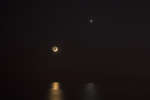 Reflections of Venus and Moon
Reflections of Venus and Moon
19.05.2018
Posing near the western horizon, a brilliant evening star and slender young crescent shared reflections in a calm sea last Thursday after sunset. Recorded in this snapshot from the Atlantic beach at Santa Marinella...
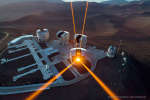 Attack of the Laser Guide Stars
Attack of the Laser Guide Stars
18.05.2018
Dodging powerful laser beams, a drone captured this stunning aerial view. The confrontation took place above the 8.2 meter diameter Very Large Telescopes of the Paranal Observatory on planet Earth. Firing during a test...
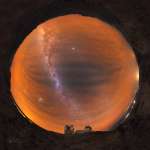 Milky Way vs Airglow Australis
Milky Way vs Airglow Australis
17.05.2018
Captured last week after sunset on a Chilean autumn night, an exceptional airglow floods this allsky view from Las Campanas Observatory. The airglow was so intense it diminished parts of the Milky Way as it arced horizon to horizon above the high Atacama desert.
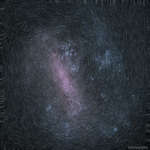 Rotation of the Large Magellanic Cloud
Rotation of the Large Magellanic Cloud
16.05.2018
This image is not blurry. It shows in clear detail that the largest satellite galaxy to our Milky Way, the Large Cloud of Magellan (LMC), rotates. First determined with Hubble, the rotation of the LMC is presented here with fine data from the Sun-orbiting Gaia satellite.
|
January February March April May June July August September October November December |
|||||||||||||||||||||||||||||||||||||||||||||||||